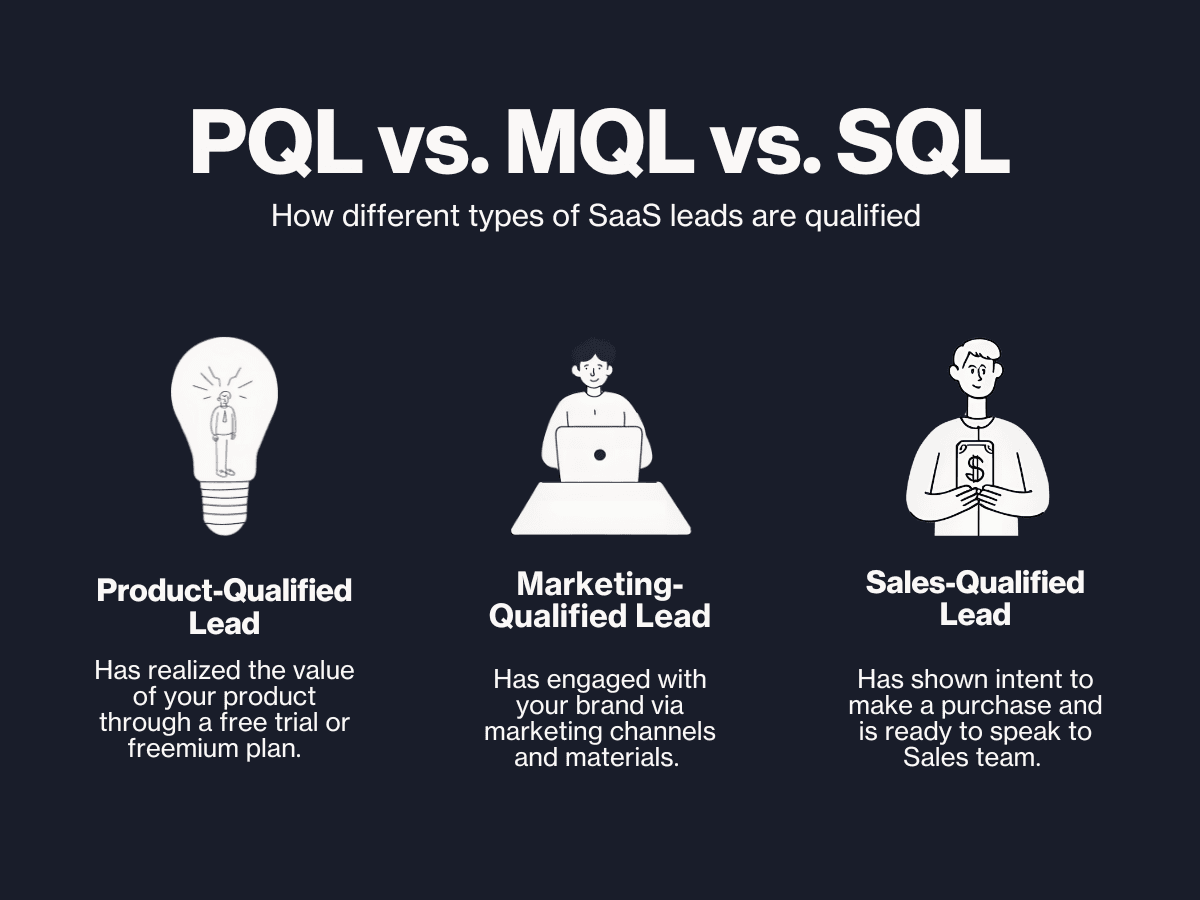Contrary to search engine snippets, not every lead that signs up for a free trial of your product is product-qualified. There's a little more to it than that.
In this guide, we'll explore:
What a product-qualified lead is
Benefits of tracking product-qualified leads
How to define what a product-qualified lead is for your business
What is a PQL (product-qualified lead)?
A product-qualified lead is a lead who signed up for a free trial or freemium plan and as Product Led's Wes Bush puts it, "experienced meaningful value using your product."
As Wes points out, that last part is important — for a lead to be product-qualified, they need to have been successful in your product. To measure this, you need to make a business-wide decision about which in-product actions and behaviors indicate success. These are referred to as product-qualifying actions. In the section below, we provide some examples and go into more detail on how to identify these for your business.
PQLs and other lead types
Most SaaS companies will already be tracking marketing-qualified leads (MQLs) and sales-qualified leads (SQLs).
A marketing-qualified lead (MQL) is a lead who has had a meaningful interaction with your marketing materials. It could be downloading an eBook, signing up to a newsletter or landing page, or engaging with your brand’s social media content.
A sales-qualified lead (SQL) takes things one step further, reaching out through a sales funnel, like a landing page, to ask about pricing or request a free trial. They may also reach out to a salesperson directly over LinkedIn or email.

These three lead types are not mutually exclusive. Leads can move from one to another, usually in the direction of MQL to PQL to SQL. For example, an MQL might decide to sign up for a free trial or freemium plan after participating in a webinar. If their experience in your free trial or freemium plan is positive and they take the product-qualifying actions you've identified, they would become an PQL. Then, if they reach out to sales to explore pricing options or to get some specific questions answered in a demo, they would become an SQL.
Benefits of PQLs
Here are just a few reasons PQLs will transform your SaaS business for the better:
PQLs help sales and marketing teams prioritize their efforts: A lead who has experienced the value of your product is as hot as they come and can be prioritized above and beyond other leads.
Actions speak louder than words: There's no clearer sign of intent than a customer taking the time to explore your product and take key actions in their free trial.
PQLs are more likely to convert and less likely to churn: When a lead has a positive onboarding experience during their free trial, they're more likely to stick around.
PQLs shorten the sales cycle: Since the prospect has used the product, they’ll have more pointed questions for your sales team which will minimize the number of meetingss and fast-track conversations.
PQLs have a higher ACV: When a lead is already convinced of your product's value, they are less likely to nickel and dime you, meaning annual contract values go up.
How to define what a PQL is for your business
In order to identify a PQL for your product, you’ll need to look at which action customers take before they become an active and engaged user, and identify the behaviors that lead to them upgrading.
This action or actions will be unique to your business. To give you an example, here are some product-qualifying actions to consider:
Hitting a usage limit on your product
Heavy use of a feature
Use of a specific product feature
Reaching success milestones (making a sale or driving engagements)
At first, identifying what exactly a PQL is for your business can feel daunting. After all, there are likely thousands of actions a customer can take with your product and many of them will be meaningful to the product experience.
The best place to start is at the end. Take a look at your existing paying customers and start to identify some of the commonalities in their behavior by speaking to your sales, marketing, and customer success teams.
You can then use this anecdotal information to guide your product usage exploration. Use data to discover what the most active customers have in common, which key features these customers use the most, when product usage begins to increase, and what freemium customers were doing with your product before they made the decision to upgrade.
With this information in hand, you’ll start to paint a picture of the customer journey to define the criteria for product-qualifed leads.
Examples of PQLs
Since no two companies have the exact same product, no two companies have the exact same definition of a product-qualified lead. But it can be helpful to see how other companies might define PQLs and how simple could might be.
Slack: A team sending 2,000 messages
Zendesk: Populating their customer-facing help center with content
WorkOS: External connections (integrations)
Dropbox: Number of file uploads
Expensify: Number of invoices sent within one month
“Based on experience of which companies stuck with us and which didn’t, we decided that any team that has exchanged 2,000 messages in its history has tried Slack–really tried it”
—Slack Founder Stewart Butterfield told Fast Company
In each of these examples, you’ll see that a PQL definition is directly tied to the true value of the product. It is an action that shows us your user has reached their ‘aha moment’.
PQL metrics that matter
A PQL is a highly-qualified lead, but it's still just a lead. You will want to track some additional metrics to ensure your PQLs are converting and make any adjustments necessary.
Raw PQLs: How many PQLs you are acquiring within an agreed-upon time period. It’s a good idea to track weekly PQLs as well as monthly so that you can see the actions marketing and product teams are taking are making an impact.
Time to PQL: In some cases, your PQL will be time-based (e.g. created a template within one week). If not, calculating how long your sign-ups are taking to reach PQL status can help you improve the product experience.
PQL Rate: This is the percentage of new sign-ups that reach PQL status in a given time period. Let’s say you get 250 sign-ups, but only 25 became a PQL within a month. That means your PQL Rate is 10% and you probably have some work to do to ensure that your marketing messages and product experience are matching up, your onboarding and activation process is easy to understand, and your customer journey is guiding users to their aha moment.
PQL Conversion Rate: To calculate your PQL conversion rate, you’ll want to look at the total number of PQLs that converted to a paid model, divided by the total number of PQLs. If this number is not favorable, take another look at the workflow you’ve put together for your PQLs and see how it could be improved upon. If it is consistently low, you may want to take another look at how you’ve defined your PQL and whether that product-qualifying action is still relevant to your product experience.
Use the table below as a guide for measuring your PQL metrics.

Product-qualifed leads FAQs
1. What is product-led growth?
Product-led growth relies on the product itself as the main vehicle for growing and retaining your customer base.
2. Will PQLs replace MQLs?
The short answer? Maybe.
To start, it’s likely PQLs will be tracked alongside MQLs while you iron out the kinks and align your team. Eventually, however, your marketing team may prioritize activities that drive raw PQLs and increase the PQL rate — that is, how many people who sign up for a free trial or freemium model because of a marketing message go on to become PQLs. If that rate is low, your marketing team will need to shift their message to ensure that the message and initial product experience marry up.
3. Will PQLs replace SQLs?
High-priority PQLs are the leads most likely to close, so the sales team will be motivated to chase these leads like it’s the last mile of a marathon. That doesn’t mean that SQLs will disappear. After all, if someone has reached out to your team directly, they’re still a qualified lead with a lot of potential.
4. Which metrics are the most important for defining PQLs?
The action the user takes is the most important part of the PQL equation and, to start, it might be all you track as you move towards a more sophisticated PQL model.
5. How will a PQL change KPIs across the organization?
Likely, your teams are already thinking about the product actions that users are taking and how they correlate with the customer’s growth.
A PQL will give them a more tangible goal here, helping marketing teams optimize towards a specific action, giving customer success teams a qualifying action to work towards, and helping sales prioritize their leads.
The PQL metrics above should be tracked and, eventually, will become KPIs across the organization. It’s very much a team effort!
6. How do I start to identify my PQLs?
Start by talking to your teams and customers to get a sense of what that product-qualified lead could look like. This anecdotal information will give you a place to start when you’re sifting through the data to identify your PQL.



